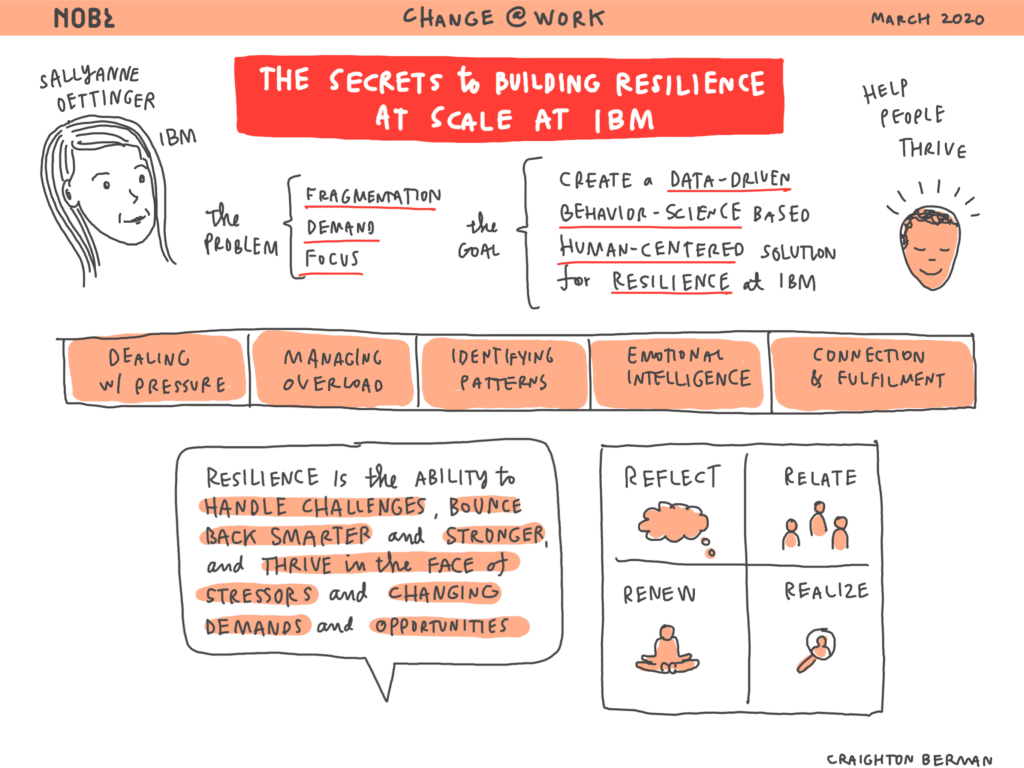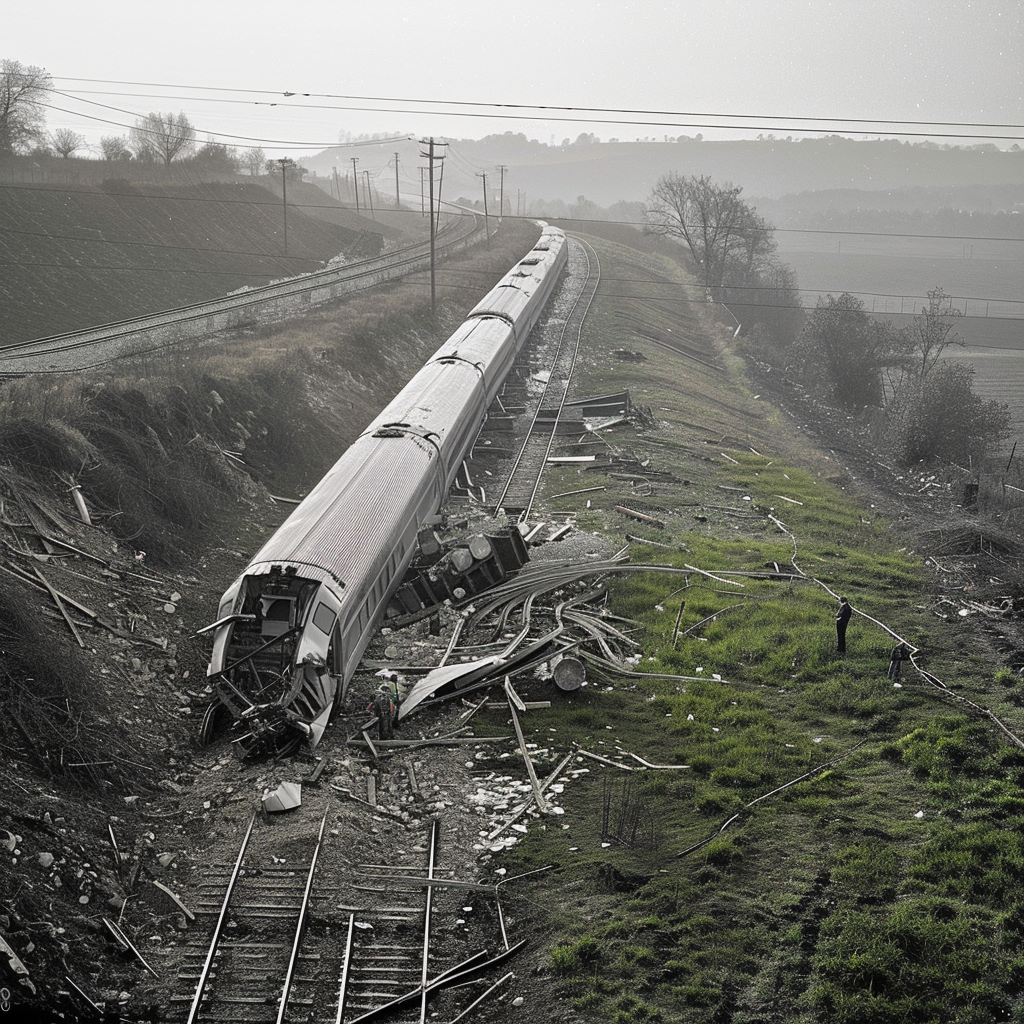When IBM realized its 360,000 employees needed support for their resilience and mental health, Sallyanne Oettinger, Learning Design Leader/Resilience Offering Manager, was tasked with developing a program that could rapidly scale to meet their needs. She shared her recommendations for other teams seeking to improve resilience:
- Establish what success looks like. Before developing any curriculum, her team discussed existing programs, as well as what measures they could use to determine the effectiveness of any new programs—how will they know IBM’ers are more resilient?
- Develop a framework. After extensive research and analysis, the team was able to identify the four key aspects of resilience—Reflect, Relate, Renew, and Realize—that all of their programs would be built around.
- Keep it lean. While the program did have an executive sponsor, but they kept programs small and rapidly iterated to demonstrate that the program worked. As a result, there’s now “tremendous” support for the program.

Read the Transcript
Sallyanne Oettinger:
Sarah introduced me. I lead a resilience program at IBM and I also lead our learning design and development team, which is a global team and we designed learning for large programs, large portfolios like leadership development and sales learning, agile learning, diversity inclusion. So I’m part of an amazing organization, and was given the really fortunate assignment to take a fresh look at our resilience program. That’s what I’ll walk you through today. Here was the business problem when we took this over, and it was about a year ago. There was a lot of different content that was fragmentation of content and programs that was being delivered across the organization, and when we say, scale and IBM and the organization, I’ll give you a sense of what that means. It’s 360,000 employees globally over 182 countries.
So scale is scale at IBM. Fragmentation is something we grapple with a lot of different programs, but there was a really vibrant, amazing mindfulness community that was developing a lot of materials. We had local site folks delivering content around different topics related to resilience and there wasn’t a central point of view, like a, “Here’s what IBM thinks about resilience, and this is what we mean when we talk about it.” So there’s a need for some coming together, an audit in a way of all that was being delivered across the globe. At the same time, there was a huge demand for this content. I mean even prior to two weeks ago or a month ago, our world was volatile and ambiguous enough and uncertain.
So there was a high demand at that time. There’s a higher demand now, but we all have seen all of the staggering statistics around burnout and anxiety. So more and more IBMers had an appetite for support in these topic areas. Then at the same time too, there was an increased focus across the organization around mental health, and how we were supporting the mental health of IBMers both through preventative measures like resilience. And then further downstream medical support through EAPs and things like that. So this was the perfect storm and the HR organization said, “Yes, we need to put our heads together, and get some focus and some momentum around a new set of resilience offerings.” The opportunity in front of us was to really understand what IBMers wanted, and what they needed, and what was getting in the way of them thriving, and being healthy, and being productive, and feeling connected, and feeling well.
So the first opportunity was to really understand IBMers and understand where they were going to currently for some of this content, whether it was inside IBM or outside IBM. We did have existing resilience curriculum. It just needed a fresh look. So based on the research and based on the data we collected, we needed to take a look at our current curriculum, and if that needed adapting. We also needed to come together and think through what is success going to look like at the end of this? Once we launch new offerings and they’re in the ecosystem, how will we know if IBMers are more resilient? How do we measure that? So, that’s an important part of our offering discipline. So we needed to look at that as well. And ultimately the opportunity in front of us was to create a data driven behavior, science-based and human centered solution to help our employees thrive in times of change, and to meet the call for transformation, which we know is happening in the business world, and in fact the extended world at a rapid pace.
So we engaged in research, we did secondary research, combing through past engagement surveys, which is engagement, like broad pulse surveys to find out when the instances of things like stress and burnout showed up in comments. We dove into those comments to look at what was driving it, and uncover some of the sentiment around burnout and stress and work life balance. And we also looked at external surveys, what other companies were doing. So we did a whole body of secondary research, and then we did internal primary research on with surveys and with interviews to understand things.
I’ve mentioned what do IBMers want? Where are they getting it currently? What’s getting in the way of them thriving in the workplace and outside of the workplace? What delivery methods do they want? It was such a rich and meaningful exercise, that research sprint, which took maybe about two months. We spent about two months on it and tons of insights surfaced, which I don’t have the time to get into today. But this is what we learned about what they want to know about, what they need help with, what they want to learn. Staying calm under work-related pressure. None of these are surprises. Don’t we all want to learn and master these managing work overload, identifying negative thought patterns, emotion control and emotional intelligence, and just an improved sense of connection and fulfillment to work? This was primarily the question was asked in more of a work setting, but we can extrapolate to imagine that there’s a hunger for an improved sense of connection in our lives broadly.
So this is what IBMers was wanted. We took that, my learning team, the very, very lean team that worked on this, which I’ll share in a few slides got really, really deep into the research. We read books, we referenced academic articles. We searched out and found experts, not who advised us personally, but whose research really guided us. And we landed on a single definition, which again was no surprise. This won’t feel unfamiliar to those of us who are in the resilience world if you think about it a lot. But we didn’t have a single definition at IBM. So we really need to land on that. And it’s by us defined as the ability to handle challenges, bounce back smarter and stronger, and thrive in the face of stressors, and changing demands and opportunities.
As much as we wanted to talk about helping individuals deal with adversity, some of the negative stressors we’d say, we also wanted to provide resources to help them rise to meet exciting opportunities. Big promotions, or being at the helm of huge projects, or winning a gigantic client engagement. Those offer us opportunities to build resilience or practice our resilience as well. So this was the definition. If I could do a little of self-reflection, as this is now in the market, it’s an internal market, but in our market, I think the piece that I’d love to wedge in here somewhere is around personal growth. It’s about a personal growth experience rather than, this could be interpreted, and the word resilience in fact is interpreted in lots of different places globally as system resilience or being really good at taking punches and bouncing back.
At the root, at the core, it’s around personal development and growth. So I’d love to modify this as we go, and change it up a bit. But that’s the definition that we landed on. And here’s our framework. So here’s the approach that we’re going with and I’ll show you a slide, that describes these categories a bit, but it’s reflect, relate, renew and realize. Reflect is about the inward journey. Realize is about strengthening relationship with others, social connection. Renew is about nourishing the mind and body, and building practices and habits around nutrition and movement and recovery. And realize is the connection to a creative purpose. So that’s the overall approach that we landed on, and all of our offerings will be built around.
Whoops, let me move on. Here is just a mood board that I wanted to share with you all so that it captures, this again is the work of our design group, and it captures the feelings we want to evoke. Lots of water elements, people have different stripes and varieties and these photographic images can be even more diverse. Our population encompasses every type of person. So that needs to be reflected, in our imagery. And so we’ll iterate on this, but this gives you a sense of what this program looks and feels like in our ecosystem. And here’s just a bit of a deeper explanation of each of our categories. Reflect, looking in more and making your mind an ally starts with introspection.
The topics that we cover under this reflect category are things like mindfulness, positive orientation, managing emotions, self-compassion. Those are the topics that sit in reflect. In relate it’s about this is not a solo journey. I mean it can be a solo journey, but your resilience will be compromised in a way without this component of social connection, which we’re all really taking for granted I think now that we’re in various forms of isolation. But that social connection can still exist and will exist. But this connecting to others is hugely important. And the topics we cover under relate our social connection and the importance of that gratitude, and helping others or altruism. Those are the topics we cover under relate. Renew is about this baseline of wellbeing and health. So we talk about recovery, movement, food.
We also have rituals in this category. So rituals for starting your day, and ending your day, and celebrating victories, and launching projects. We’re excited about that one. So we’ve got rituals and also energy management in the renew category. And then in realize we have purpose and work life. We haven’t landed on work life balance, work life integration. We’re right now being neutral in that space and calling it work life. That’s a deeper dive into our approach and-
Sarah Dickinson:
Fantastic Sallyanne.
Sallyanne Oettinger:
Yeah shall I pause here?
Sarah Dickinson:
I mean it feels like this would be a wonderful place to pause, because we’ve already got a bunch of questions coming in from the floor. I think you’ve set the scene for us fantastically in terms of your frame on what can be a very heady, somewhat nebulous topic. And I love already the introduction that you’ve given us in terms of practices, that you’re building out and encouraging others to do. Can we take some questions? Is that okay with you?
Sallyanne Oettinger:
Absolutely. You’ve got the driver wheel.
Sarah Dickinson:
Awesome.
Sallyanne Oettinger:
Yes, I’ll take your lead.
Sarah Dickinson:
Then thank you. I mean, I think I was curious about working with others in the organization. How did you get other execs the air cover you needed to care about the this initiative? How do you plan to in terms of taking this forward?
Sallyanne Oettinger:
Yeah, well I’ll speak to that and then there’s a slide I have about the internal IBM ecosystem. Our vice president who has leadership learning and inclusion about an 800 person organization in HR, she is a huge advocate for and proponent of resilience. It’s just been something she’s believed in since day one. So, there was tremendous support for her, but maybe now is a good time to reveal that it wasn’t a big program that we were rolling out. This was done with a couple of learning designers and a graphic designer. We didn’t have any program dollars or any big budget. This is an important HR initiative for sure, but the type and the scope and the volume of other HR initiatives at a company like IBM, this was a teeny tiny initiative really.
So we had the support we needed, we ran under the radar screen and built all this. We were going to launch first few weeks of April with most of our stuff. All of our offerings right now are digital, but super interactive digital. We really needed to make it an active learning experience. But because of the coronavirus we wanted to get, and all of IBM pulling all of its workers, those that can be remote to be remote. We needed to really fast track this. We got it done, we sprinted to the finish. It was about 80% done and then we got the last 20% done in a couple of days, and launched it as part of the support around coronavirus resources. So now there’s tremendous HR support for all and executive support for all programs that can help IBMers, and IBMers family during this time. So, if that answers your question, a bit long winded.
Sarah Dickinson:
No, no, it’s great. I mean, I love the very resilient and adaptive approach you took to getting this thing out much more quickly than you plan to I think we are unfortunately out of time.
Sallyanne Oettinger:
Oh my gosh. Darn it. I’m so sorry.
Sarah Dickinson:
No, there’s no sorry. This has been incredibly helpful, and very, very inspiring. Just understanding the practices, and the lens that IBM is taking through this is so, so helpful and we’re incredibly grateful for your time today Sallyanne.
Sallyanne Oettinger:
Thank you Sarah. Real apologies for not going quicker. Please hit me up on LinkedIn for anyone who wants to have a discussion separately about this. I’m happy to connect and thank you for having me.
Sarah Dickinson:
Fantastic. Fantastic. Thank you so much.













